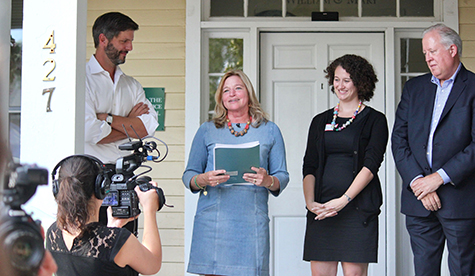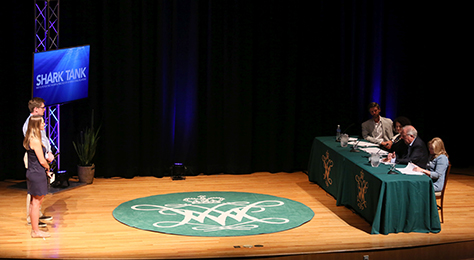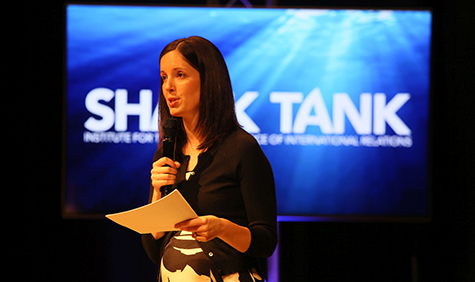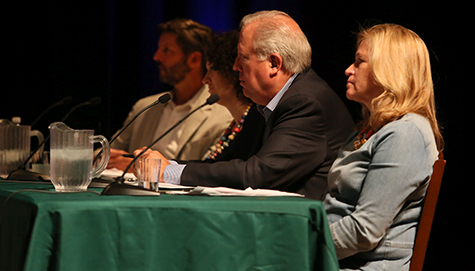Shark Tank rewards entrepreneurial solutions to real-world problems
The dazzling set, cameras, dramatic lighting and air of expectation were comparable to its television namesake, but the third annual Shark Tank, hosted by The Institute for the Theory and Practice of International Relations (ITPIR) in Commonwealth Auditorium on Aug. 3, gave the concept a uniquely W&M spin.
Whereas the Mark Burnett-produced reality show attracts viewers with promises of multi-million investments, sparkly marketing campaigns, Scrub Daddy sponges and pheromone-infused hair products, ITPIR’s Shark Tank drew a robust audience and impressive panel of sharks not only because of what it promises but also what it delivers: student-faculty partnerships using their creativity, skill and interests to find innovative solutions to international challenges, thanks in large part to generous private funding. As ITPIR Co-Director Mike Tierney said in his introduction, “ITPIR incubates student-faculty research projects that are international, interdisciplinary and policy relevant. One of my favorite ITPIR programs is the Shark Tank … Their ideas and sweat equity actually provide the foundation for many existing projects here at ITPIR.”
Who’s to say that isn’t at least as important as the Simply Fit Board - The Workout Board with a Twist?
The sharks
The Sharks, or panel of judges, assembled for the event were W&M alumni and distinguished experts in their fields:
- Ambassador Thomas Shannon, Jr. '80, Under Secretary of State for Political Affairs
- Ellen Stofan '83, D.Sc. ’16, former Chief Scientist of NASA
- Thomas Benedetti '92, co-founder of and Partner at Blue Heron Capital, and
- Alena Stern '12, senior program manager at AidData
The pitches
The seven projects presented over the course of two hours were the culmination of a 10-week course on Policy Entrepreneurship taught by ITPIR staff members David Trichler, Rebecca Latourell, Duenya Hassan and Jake Sims. The students brought a variety of majors, backgrounds and interests to their approaches, and the seven projects were as creative and thoughtful as they were different, showing that the good data is applicable to multiple disciplines and areas of analysis.
Using storytelling and compelling graphics, they described how they would use data to improve decision making and understanding.
"Why Microfinance Needs Machine Learning" (Abby Bilenkin ’20, Vincent Taday ’20; Mentor: Siddharta Ghose)
Abby Bilenkin started the afternoon with a presentation about microfinance and machine learning. Her partner, Vincent Taday, was not able to join her, but she didn't miss a beat. On a cursory level, even outside the development field, most people are familiar with microcredit and microfinance, but the question addressed by Bilenkin and Taday is how to measure the actual effectiveness. They identify two issues: the repayment rate of microloans could be higher, enabling more loans to more people; and data scientists bring different skills than professionals in microfinance and could improve the efficiency of the process. In their minds, repayment rate misses the point. The goal should be wealth creation, and their proposal would help predict whether a microloan would also positively impact the local economy.
They posit that machine learning algorithms predict loan repayment more accurately than human evaluators. Machine learning is used in conventional banks, and computers are better than people at reducing mistakes by 13.7 percent.
Questions from the judges mostly concerned how to identify and choose the best datasets, and one question was if the project would put single women at a disadvantage, since there is very little data about them. Bilenkin had clearly thought about that, and said they, too, were concerned and were going to incorporate that thinking in their algorithms, much the way it is done in affirmative action. When the issue of potential predatory lending in South Africa was raised, Belikin responded: “I was just reading an article about that in the Guardian.” And then she proceeded to discuss the concerns and how they were going to address them in their project.
"Comparing Donor and Recipient Priorities" (Allie Cooper ’19 and Chris Elsner ’20; Mentor: Jake Sims)
Allie Cooper and Chris Elsner focused on the lack of accountability and relevance to recipient priorities in foreign aid. Using the United Nation’s 17 Sustainable Development Goals as a guide, the goals and targets were formulated to stimulate action over the next 15 years in areas of critical importance for humanity and the planet and range from No Poverty (#1) to Gender Equality (#5) and Partnerships for the Goals (#17).
Cooper and Elsner propose creating the first map for SDGs for three countries: Colombia, Malawi and Uganda. They would rank the donors and their effects. Stofan led the questioning by noting the overlap of the SDGs would make it difficult to narrow down to a goal, and had the students considered concentrating on just a few of the goals. Their response was that they would be coding to the goal level, using the SDGs as broad guidelines. Other questions involved how to weed out the appropriate data and also to differentiate, as Stern noted, the difference in the specialization of a donor from the goal of the recipients. Stofan cautioned that it would be important to focus on the achievable. Elsner clarified that the goal was to map out where the gaps are as a tool for donors to see. Shannon pointed out that accountability and meeting felt needs were the most difficult issues in the field. Elsner responded that his goal is to publish what they find and make the information available.
"Indexing Taxation" (George Moss, UVA ’20 and Caroline Nutter ’18; Mentor: David Trichler)
If the statement “Tax capacity is essential to the macroeconomic, social and institutional development of all countries” is a bit intimidating, this project can best be summed up this way: Helping Countries Help Themselves.
Their project analyzes how countries and localities collect taxes. The premise is that in the developing world, because there are not effective means of collecting taxes, the countries have more means at their disposal than they’re able to access. The tax revenue is 10-20 percent of GDP in developing countries versus 40-50 percent of GDP in developed countries. They estimate the equivalent of $100 billion is lost in tax revenue each year.
Moss and Nutter want to create a tax capacity index to be used by public finance researchers, policymakers and practitioners for benchmarking domestic resource mobilization. It will consist of downloadable data in a public domain that’s accessible and user-friendly.
Shannon pointed out that it is important to find indications of corruption and poor business activity, but that it’s hard to find data: “I know, because I’ve looked,” he said.
Shannon also remarked that with Moss from UVA and Nutter from W&M combining forces, “Thomas Jefferson would be pleased.”
"Mapping Food Insecurity" (Maxim Maiello ’19 and Elizabeth Sutterlin ’20; Mentor: Rebecca Latourell)
If you want to show that your project is worth doing, it surely doesn’t hurt to start your presentation by quoting an expert. Food deserts are not unique to developing countries – many urban and rural parts of the U.S. struggle with the same problems – and this project addresses the need for data to diagnose the issues. Maiello and Sutterlin started their presentation about the need for their project by quoting Arif Husain, chief economist and head of food security analysis service at the United Nations World Food Programme. In an email exchange, Husain told them that “data (on food insecurity) is sparse at best.” Domestic urban growth stresses the food supply and forces vulnerable populations to rely on informal food sources without nutritious or economic options. Such food vendors are unmapped and understudied.
Maiello and Sutterlin will focus on Hyderabad, India, to locate and map the locations of food vendors and other markets. Using cell phone data of food-insecure populations, they will map the routes between homes and food sources in order to help improve access to food by identifying the most in-need neighborhoods and city sectors; targeting efficient locations for food aid; and recommending improvements in planning for urban planners and city officials. Stofan suggested focusing on the vendors rather than trying to glean information from the customers, and the other Sharks also advised them to consider what kinds of information they’ll be tracking and what it will indicate.
"Global Media Perceptions of U.S. Foreign Policy (Katherine Armstrong ’20 and Jack Shangraw ’20, Mentor: Marcus Holmes)
This proposal is based on the premise that the success of U.S. foreign policy is influenced by America’s soft power. Although there is some ad hoc monitoring of opinion, Armstrong and Shangraw propose using web-scraping and sentiment analysis to track real-time attitudes towards the U.S. in foreign media. They would be creating a real-time trends map from their Sentiment Tracking Tool, which does not currently exist. With this information as context, U.S. policymakers and implementers will be better able to convey U.S. interests abroad and observe the impact. The Sharks asked about the value of following media outlets as opposed to social media or other data. Armstrong and Shangraw explained that they would begin by identifying the key media outlets to track, and that they would also compare it with public opinion polling to get a balanced sense of the mood in a country.
"Identity Messaging and Environmental Development" (Michael Giovanniello ’20 and Anatoly Osgood ’20; Mentor: Dan Maliniak)
Environmental sustainability and climate change mitigation projects are often hindered by the inability to convey their impact or urgency. Giovanniello and Osgood offer this hypothesis: If individuals perceive their group as prioritizing climate change action, they will have higher support for local environmental development projects. With methodologies developed to understand how political identity impacts one’s climate change knowledge, they will examine the effect of social connotations on making environmental development efforts more relevant to communities. Their hope is to show how group-identity increases support, which could improve communication strategies through all development fields. They intend to travel to Nicaragua, where they already have contacts in the Peace Corps. Shannon reflected that having “outsiders” or foreigners deliver aid in the Ebola crisis caused some resistance among local populations, and Stofan suggested a way to engage local farmers would be to ask them what they are noticing, creating common ground and a starting point for exchange and discussion.
"Tracking Targets: Identifying Ethnic Minority Violence" (Sami Tewolde ’19 and Lincoln Zaleski ’20; Mentor: Dan Runfola)
Tewolde and Zaleski took the stage with a clear definition of the problem: Data on ethnic minority violence is scattered. Organizations are aiming in the dark because there’s also a lack of access to where this ethnic violence occurs. Their solution is the creation of a tool that will bring critical geospatial information to organizations that affect change. They can do a basic two-dimensional map of the acts of violence, but their hope would be to create a much more versatile and data-rich interactive map. They had already investigated potential users or customers. They asked organizations if it would be useful and they got a resounding yes: “A geocoded map of ethnic violence would be an essential tool for the international community. ... This is not something we already have, and we need to.” - Arslan Malik (former UN peacekeeping senior policy advisor); and “A geocoded map would be extremely useful ... and this is an enormously important area." -Johanna Birnir (director, All Minorities at Risk).
They see the potential of the project as a building block and ongoing tool for analysis. It also is a widespread problem with a large scale population impact. Ethnic discrimination or violence affects all countries in Asia and the Middle East but three. Millions of people are affected.
Winners
After the seven impressive research pitches, the Sharks had a difficult deliberation and split the $20,000 between three teams, who will begin their research in the fall:- "Indexing Taxation: A Measurement Index of Tax Capacity in over 190 Countries," by George Moss (UVA '20) and Caroline Nutter '18, was fully funded at $5,000.
- "Tracking Targets: Identifying Ethnic Minority Violence," by Sami Tewolde '19 and Lincoln Zaleski '20, was fully funded at $8,340.
- "Group-Identity Messaging and Support for Environmental Development Projects," by Michael Giovanniello '20 and Anatoly Osgood '20, was funded at $6,660.
The future
In his questioning of Belikin, Shannon asked her what she would consider success. She thought for a moment and responded: “It would be that we were using research to apply to the real world … that this research was used somewhere and helped people.”
What Belikin expressed so well is true for all the students and their projects. As Tierney said at the beginning of the afternoon: “Our researchers apply social science methods to real-world problems. We seek to teach through research, to create new knowledge, and to have an impact in the world.”




















